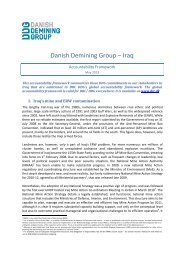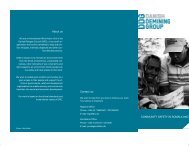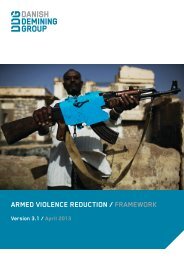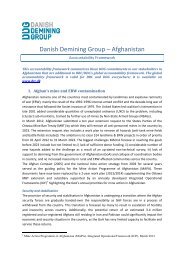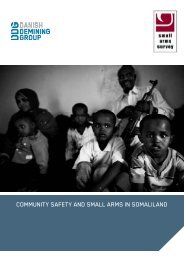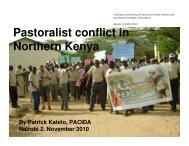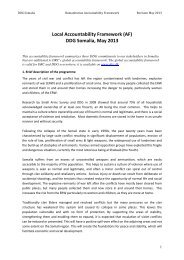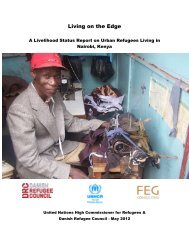Read the full report - Danish Refugee Council
Read the full report - Danish Refugee Council
Read the full report - Danish Refugee Council
Create successful ePaper yourself
Turn your PDF publications into a flip-book with our unique Google optimized e-Paper software.
CASH PROGRAMME REVIEW FOR IDPs IN KABUL INFORMAL SETTLEMENTS 5EXECUTIVE SUMMARYAlthough much has been done to better understand <strong>the</strong> profiles and needs of internally displacedpersons (IDPs) in Afghanistan1, in 2013, at a time of growing forced internal displacement and ofupcoming political and military transition, key questions remain. With internal displacement being oneof <strong>the</strong> key humanitarian priorities in Afghanistan, and with numbers exceeding half a millionindividuals displaced from <strong>the</strong>ir homes, <strong>the</strong> question is whe<strong>the</strong>r stakeholders have envisaged allavailable options of assistance. This is particularly true of <strong>the</strong> case of urban settings, home togrowing numbers of IDPs living in informal settlements. Donors express scepticism on continuedhumanitarian interventions in <strong>the</strong>se urban settings, and <strong>the</strong> overall political stance on internaldisplacement and informal settlements prevents structural interventions to alleviate protection needswith IDPs living, often illegally and informally, on government or private-owned land. However, with<strong>the</strong> development of <strong>the</strong> first National IDP Policy, it may well be <strong>the</strong> time for stakeholders to thinkconstructively about breaking <strong>the</strong> cycle of poverty and indebtedness of IDPs living in <strong>the</strong> KabulInformal Settlements (KIS) and to ask:What types of interventions are <strong>the</strong> most appropriate, relevant and effective, in an urban contextwhere displaced households live in informal settlements, without deeds to <strong>the</strong>ir land or shelter, oftensquatting private or government land? What opportunities exist, if any, for cash-based assistance torespond to <strong>the</strong> needs of internally displaced populations (IDPs) living in <strong>the</strong> Kabul InformalSettlements?With <strong>the</strong>se questions in mind and with an expanding livelihoods programme, <strong>the</strong> <strong>Danish</strong> <strong>Refugee</strong><strong>Council</strong> (DRC) commissioned Samuel Hall Consulting to undertake a research study and review of<strong>the</strong> relevance and applicability of cash-based programming options in <strong>the</strong> KIS. As media <strong>report</strong>s from<strong>the</strong> winter 2012 have illustrated, illness and death among <strong>the</strong> elderly and children were commonoccurrences in <strong>the</strong> harsh winter conditions. As a result, <strong>the</strong> humanitarian community – along with <strong>the</strong>Government of Afghanistan – have stepped up coordination efforts to ensure increased emergencyassistance capacity to cope in <strong>the</strong> winter. DRC and Samuel Hall researchers have focused thisresearch on identifying <strong>the</strong> risks and protection issues for a cash approach, and assessing <strong>the</strong>viability of a cash approach for IDPs living in <strong>the</strong> KIS.A total of 310 respondents were interviewed in 8 KIS sites relevant to DRC’s programming. Theintention was not to have a representative sample of IDPs in all KIS, but to collect such informationthat is relevant to DRC’s work. The sampling was limited to 8 sites where DRC is currently active andcomparison between camps is made <strong>the</strong>re where data was available. In each site, an average of 40households was surveyed randomly (except for 30 households covered in <strong>the</strong> last location),comprising a total of 72 female respondents (23% of respondents) and 238 male respondents (77%).The study was conducted during <strong>the</strong> winter months of 2012, a time of <strong>the</strong> year when IDPs in <strong>the</strong> KISare exposed to higher protection risks. One of <strong>the</strong> salient features of this research is <strong>the</strong> structuralimportance of seasonality, highlighting <strong>the</strong> importance of having specific frameworks of assistanceduring <strong>the</strong> winter period, as developed in <strong>the</strong> recommendations section of this <strong>report</strong>.Assessing vulnerabilitiesThis study confirmed <strong>the</strong> existence of displacement-induced vulnerabilities. The lack of marketableskills adapted to urban settings, <strong>the</strong> strong reliance on <strong>the</strong> head of household and hence highdependency rations, unstable and low income sources and an over-reliance on debts, define <strong>the</strong>1MAJIDI, N. (2011), Urban Returnees and Internally Displaced Persons in Afghanistan, in 2011 Responding to Conflict-InducedDisplacement in Protracted <strong>Refugee</strong> Situations: Middle East Institute (MEI) and <strong>the</strong> Foundation pour la Recherche Stratégique(FRS), “Pathways to Enhancing Transatlantic Cooperation”. NRC/IDMC/JIPS/SAMUEL HALL CONSULTING (2012), Challengesof IDP protection in Afghanistan: Research study on <strong>the</strong> protection of internally displaced persons in Afghanistan.SAMUEL HALL CONSULTING (2012), Sustaining <strong>the</strong> Working Poor in <strong>the</strong> Kabul Informal Settlements, Solidarités International.METCALFE, V., HAYSOM, S. and MARTIN, E. (2012), Sanctuary in <strong>the</strong> City? Urban Displacement and Vulnerability in Kabul,HPG Working Paper; WB/UNHCR (2011), A research study on IDPs in urban settings, Afghanistan.



